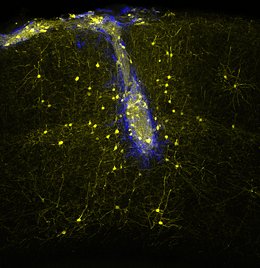
As shown in this in vivo two-photon image, neuronal transplants (blue) connect with host neurons (yellow) in the adult mouse brain in a highly specific manner, rebuilding neural networks lost upon injury. (credit: Sofia Grade/LMU/Helmholtz Zentrum München)
Previous studies have suggested there is potential to remedy at least some of the clinical symptoms resulting from acquired brain disease through the transplantation of fetal nerve cells into damaged neuronal networks. However, it has not been clear whether transplanted intact neurons could be sufficiently integrated to result in restored function of the damaged network.
Now, in study published in Nature, the researchers have found that transplanted embryonic nerve cells properly differentiated into pyramidal cells, forming normal synaptic connections, responding to visual stimuli, and carrying out the tasks performed by the damaged cells (videos here).
The researchers were also «astounded» to find that the replacement neurons grew axons throughout the adult brain, reaching proper target areas, and receiving
This includes neocortical circuits that normally never incorporate new neurons in the adult brain.
In addition, after 2–3 months, the transplanted neurons were fully integrated in the brain, showing functional properties indistinguishable from the original neurons.
The study was supported by funding from the German Research Foundation (DFG).


